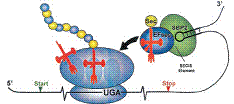Biochemistry, Department of

Vadim Gladyshev Publications
Document Type
Article
Date of this Version
June 2006
Abstract
Parasites, which cause an enormous burden in the population of the third world, are a diverse group of organisms, many of which are sensitive to oxidative stress imposed by their hosts. In recent years, several selenoprotein families, some with antioxidant properties, have been described and characterized in metazoan parasites. Glutathione peroxidase and thioredoxin glutathione reductase (TGR) appear to be essential selenoproteins in flatworms (phylum Platyhelminthes). TGR is the single enzyme that provides reducing equivalents to both thioredoxin and glutathione pathways, in contrast to hosts, which evolve parallel pathways. In roundworms (phylum Nematoda), selenoproteins have recently been described, revealing species differences in the Sec/Cys protein sets and the presence of an unusual SECIS element. Plasmodium sp, one of the most important protozoan parasites that affect humans, also decode Sec. The selenoprotein families encoded by Plasmodial genomes have neither Sec nor Cys homologs in their hosts, raising the possibility that targeting their selenoproteomes may provide new treatment strategies.


Comments
Published in Selenium: Its molecular biology and role in human health, Second Edition, edited by Dolph L. Hatfield, Marla J. Berry, and Vadim N. Gladyshev. Springer Science+Business Media LLC, 2006. Pages 355–366. Copyright © 2006 Springer Science+Business Media LLC. Used by permission.